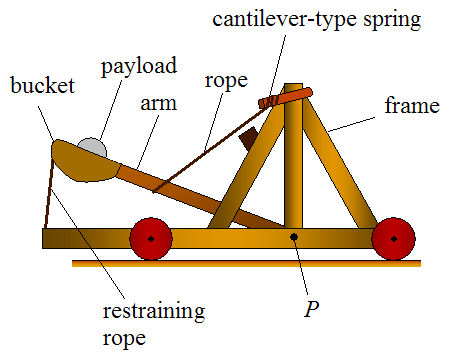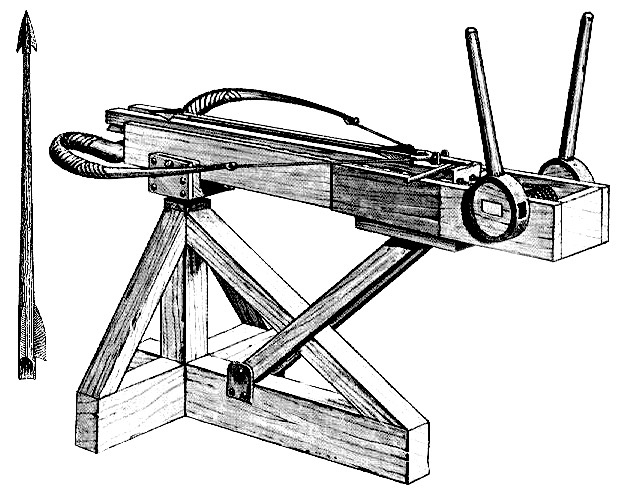|
Gastraphetes
The gastraphetes ( grc, γαστραφέτης, , belly-releaser), also called belly bow or belly shooter, was a hand-held crossbow used by the Ancient Greeks. It was described in the 1st century AD by the Greek author Heron of Alexandria in his work ''Belopoeica'', which draws on an earlier account of the famous Greek engineer Ctesibius (fl. 285–222 BC). Heron identifies the gastraphetes as the forerunner of the later catapult, which places its invention some unknown time prior to c. 420 BC. Unlike later Roman and medieval crossbows, spanning the weapon was not done by pulling up the string, but by pushing down an elaborate slider mechanism. Description A fairly detailed description and drawing of the gastraphetes appears in Heron's ''Belopoeica'' (Ancient Greek Βελοποιικά, English translation: ''On arrow-making''), drawn from the account by the 3rd-century BC engineer Ctesibius. The weapon was powered by a composite bow. It was cocked by resting the stomach in a ... [...More Info...] [...Related Items...] OR: [Wikipedia] [Google] [Baidu] |
Crossbow
A crossbow is a ranged weapon using an elastic launching device consisting of a bow-like assembly called a ''prod'', mounted horizontally on a main frame called a ''tiller'', which is hand-held in a similar fashion to the stock of a long firearm. Crossbows shoot arrow-like projectiles called '' bolts'' or ''quarrels''. A person who shoots crossbow is called a '' crossbowman'' or an ''arbalist'' (after the arbalest, a European crossbow variant used during the 12th century). Although crossbows and bows use the same launch principle, the difference is that an archer must maintain a bow's draw manually by pitching the bowstring with fingers, pulling it back with arm and back muscles and then holding that same form in order to aim (which distresses the body and demands significant physical strength and stamina); while a crossbow utilizes a locking mechanism to maintain the draw, limiting the shooter's exertion to only pulling the string into lock and then releasing the shot b ... [...More Info...] [...Related Items...] OR: [Wikipedia] [Google] [Baidu] |
Ballista
The ballista (Latin, from Greek βαλλίστρα ''ballistra'' and that from βάλλω ''ballō'', "throw"), plural ballistae, sometimes called bolt thrower, was an ancient missile weapon that launched either bolts or stones at a distant target. Developed from earlier Greek weapons, it relied upon different mechanics, using two levers with torsion springs instead of a tension prod (the bow part of a modern crossbow). The springs consisted of several loops of twisted skeins. Early versions projected heavy darts or spherical stone projectiles of various sizes for siege warfare. It developed into a smaller precision weapon, the '' scorpio'', and possibly the '' polybolos''. Greek weapon The early ballistae in Ancient Greece were developed from two weapons called oxybeles and gastraphetes. The gastraphetes ('belly-bow') was a handheld crossbow. It had a composite prod and was spanned by bracing the front end of the weapon against the ground while placing the end of a ... [...More Info...] [...Related Items...] OR: [Wikipedia] [Google] [Baidu] |
Catapult
A catapult is a ballistic device used to launch a projectile a great distance without the aid of gunpowder or other propellants – particularly various types of ancient and medieval siege engines. A catapult uses the sudden release of stored potential energy to propel its payload. Most convert tension or torsion energy that was more slowly and manually built up within the device before release, via springs, bows, twisted rope, elastic, or any of numerous other materials and mechanisms. In use since ancient times, the catapult has proven to be one of the most persistently effective mechanisms in warfare. In modern times the term can apply to devices ranging from a simple hand-held implement (also called a "slingshot") to a mechanism for launching aircraft from a ship. The earliest catapults date to at least the 7th century BC, with King Uzziah, of Judah, recorded as equipping the walls of Jerusalem with machines that shot "great stones". Catapults are mentioned in Yajurv ... [...More Info...] [...Related Items...] OR: [Wikipedia] [Google] [Baidu] |
Biton (writer)
Biton of Pergamon ( gr, Βίτων) was an ancient Greek writer and engineer, who lived in the second or third century BC. Only two of his works are known: a lost book on optics, entitled ''Optics'', and an extant short treatise on siege machines, ''Construction of War Machines and Catapults'' ( grc, Κατασκευαὶ πολεμικω̑ν ὄργάνων καὶ καταπαλτικω̑ν).Simon Hornblower, "Biton", in Simon Hornblower and Antony Spawforth (eds.), ''The Oxford Classical Dictionary'', 3rd rev. ed. (Oxford University Press, 2005). The Greek may be transliterated ''Kataskeuai polemikon organon kai katapaltikon''. The military treatise is dedicated to a king named Attalus ( grc, Ἄτταλος), evidently a king of Pergamon, either Attalus I (241–197) or Attalus II (159–38). Some scholars have suggested, based on internal evidence, that the text should date to 156–55.Francesco Fiorucci, "Biton of Pergamon", in Roger S. Bagnall, Kai Brodersen, Craige B. Champ ... [...More Info...] [...Related Items...] OR: [Wikipedia] [Google] [Baidu] |
Oxybeles
The oxybeles ( el, οξυβελής) was a weapon used by the Ancient Greeks starting in 375 BC. The word is derived from Ancient Greek: οξύς (''oxys'' = sharp, pointed) and βέλος (''belos'' = arrow). The weapon was basically an oversized gastraphetes, a composite bow placed on a stand with a stock and a trigger. It was supplanted by the scientifically engineered ballista. The difference between the two is the use of torsion power by the ballista. The most notable use of the oxybeles was under Alexander the Great's rule. Notes Ancient Greek military terminology Ancient Greek artillery {{artillery-stub ... [...More Info...] [...Related Items...] OR: [Wikipedia] [Google] [Baidu] |
Pythagoreanism
Pythagoreanism originated in the 6th century BC, based on and around the teachings and beliefs held by Pythagoras and his followers, the Pythagoreans. Pythagoras established the first Pythagorean community in the ancient Greek colony of Kroton, in modern Calabria (Italy). Early Pythagorean communities spread throughout Magna Graecia. Pythagoras' death and disputes about his teachings led to the development of two philosophical traditions within Pythagoreanism. The ''akousmatikoi'' were superseded in the 4th century BC as a significant mendicant school of philosophy by the Cynics. The ''mathēmatikoi'' philosophers were absorbed into the Platonic school in the 4th century BC. Following political instability in Magna Graecia, some Pythagorean philosophers fled to mainland Greece while others regrouped in Rhegium. By about 400 BC the majority of Pythagorean philosophers had left Italy. Pythagorean ideas exercised a marked influence on Plato and through him, on all of Western p ... [...More Info...] [...Related Items...] OR: [Wikipedia] [Google] [Baidu] |
Taranto
Taranto (, also ; ; nap, label=Tarantino dialect, Tarantino, Tarde; Latin: Tarentum; Old Italian: ''Tarento''; Ancient Greek: Τάρᾱς) is a coastal city in Apulia, Southern Italy. It is the capital of the Province of Taranto, serving as an important commercial port as well as the main Italian naval base. Founded by Spartans in the 8th century BC during the period of Greek colonisation, Taranto was among the most important in Magna Graecia, becoming a cultural, economic and military power that gave birth to philosophers, strategists, writers and athletes such as Archytas, Aristoxenus, Livius Andronicus, Heracleides of Tarentum, Heracleides, Iccus of Taranto, Iccus, Cleinias of Tarentum, Cleinias, Leonidas of Tarentum, Leonidas, Lysis of Taras, Lysis and Sosibius of Tarentum, Sosibius. By 500 BC, the city was among the largest in the world, with a population estimated up to 300,000 people. The seven-year rule of Archytas marked the apex of its development and recognition of i ... [...More Info...] [...Related Items...] OR: [Wikipedia] [Google] [Baidu] |
Cumae
Cumae ( grc, Κύμη, (Kumē) or or ; it, Cuma) was the first ancient Greek colony on the mainland of Italy, founded by settlers from Euboea in the 8th century BC and soon becoming one of the strongest colonies. It later became a rich Roman city, the remains of which lie near the modern village of Cuma, a ''frazione'' of the ''comune'' Bacoli and Pozzuoli in the Metropolitan City of Naples, Campania, Italy. The archaeological museum of the Campi Flegrei in the Aragonese castle contains many finds from Cumae. History Early The oldest archaeological finds by Emil Stevens in 1896 date to 900–850 BCE and more recent excavations have revealed a Bronze Age settlement of the ‘ pit-culture’ people, and later dwellings of Iron Age Italic peoples whom the Greeks referred to by the names Ausones and Opici (whose land was called Opicia). The Greek settlement was founded in the 8th century BCE by emigrants from cities of Eretria and Chalcis in Euboea, next to a ... [...More Info...] [...Related Items...] OR: [Wikipedia] [Google] [Baidu] |
200910311250MEZ Saalburg-Museum, Gastraphetes
91 may refer to: Years * 91 BC * AD 91 * 1991 * 2091 * etc. Transportation * List of highways numbered * 91 Line, a rail line * Saab 91, an aircraft Other uses * 91 (number) * '' 91:an'', a Swedish comic * ''91'', a 2017 album by Jamie Grace * Ninety One (group), a Kazakh boy group * Ninety-One (solitaire) * Ninety One plc, an Anglo-South African asset management business * Protactinium Protactinium (formerly protoactinium) is a chemical element with the Symbol (chemistry), symbol Pa and atomic number 91. It is a dense, silvery-gray actinide metal which readily reacts with oxygen, water vapor and inorganic acids. It forms various ..., atomic number 91 See also * * {{Numberdis ... [...More Info...] [...Related Items...] OR: [Wikipedia] [Google] [Baidu] |
Miletus
Miletus (; gr, Μῑ́λητος, Mī́lētos; Hittite transcription ''Millawanda'' or ''Milawata'' ( exonyms); la, Mīlētus; tr, Milet) was an ancient Greek city on the western coast of Anatolia, near the mouth of the Maeander River in ancient Ionia. Its ruins are located near the modern village of Balat in Aydın Province, Turkey. Before the Persian rule that started in the 6th century BC, Miletus was considered among the greatest and wealthiest of Greek cities. Evidence of first settlement at the site has been made inaccessible by the rise of sea level and deposition of sediments from the Maeander. The first available evidence is of the Neolithic. In the early and middle Bronze Age the settlement came under Minoan influence. Legend has it that an influx of Cretans occurred displacing the indigenous Leleges, and the site was renamed Miletus after a place in Crete. Recorded history at Miletus begins with the records of the Hittite Empire, and the Mycenaean records ... [...More Info...] [...Related Items...] OR: [Wikipedia] [Google] [Baidu] |
Roman Crossbow
Roman or Romans most often refers to: *Rome, the capital city of Italy *Ancient Rome, Roman civilization from 8th century BC to 5th century AD *Roman people, the people of ancient Rome *''Epistle to the Romans'', shortened to ''Romans'', a letter in the New Testament of the Christian Bible Roman or Romans may also refer to: Arts and entertainment Music *Romans (band), a Japanese pop group * ''Roman'' (album), by Sound Horizon, 2006 * ''Roman'' (EP), by Teen Top, 2011 *"Roman (My Dear Boy)", a 2004 single by Morning Musume Film and television *Film Roman, an American animation studio * ''Roman'' (film), a 2006 American suspense-horror film * ''Romans'' (2013 film), an Indian Malayalam comedy film * ''Romans'' (2017 film), a British drama film * ''The Romans'' (''Doctor Who''), a serial in British TV series People *Roman (given name), a given name, including a list of people and fictional characters *Roman (surname), including a list of people named Roman or Romans *Ῥωμαῖ ... [...More Info...] [...Related Items...] OR: [Wikipedia] [Google] [Baidu] |







